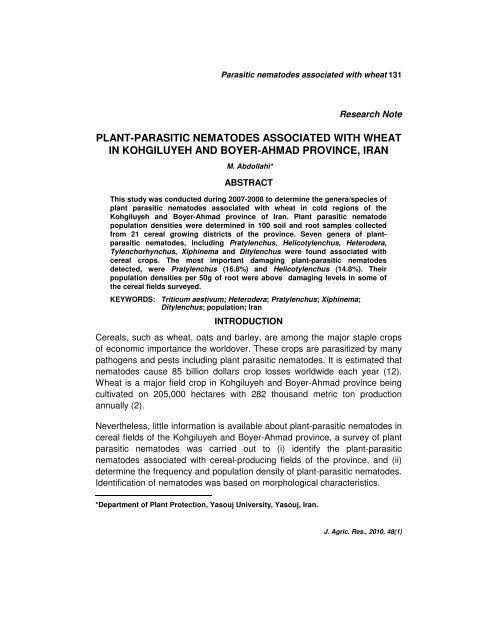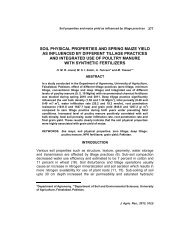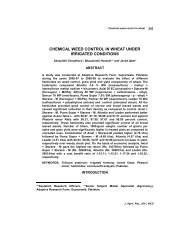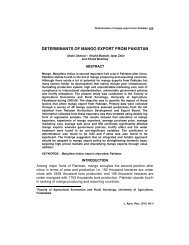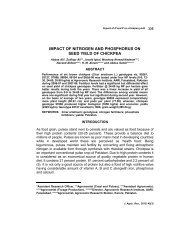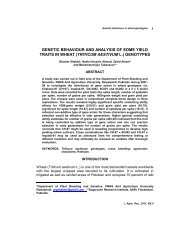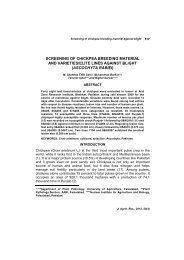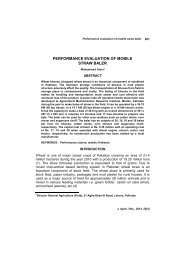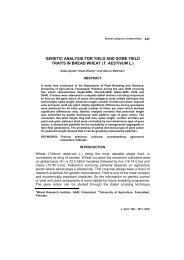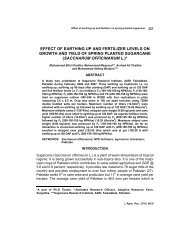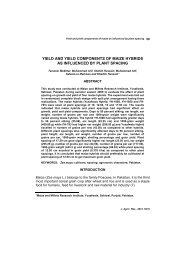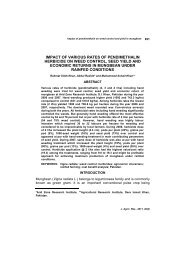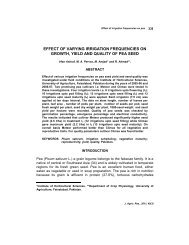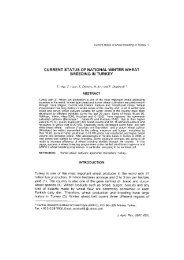plant-parasitic nematodes associated with wheat in kohgiluyeh and ...
plant-parasitic nematodes associated with wheat in kohgiluyeh and ...
plant-parasitic nematodes associated with wheat in kohgiluyeh and ...
Create successful ePaper yourself
Turn your PDF publications into a flip-book with our unique Google optimized e-Paper software.
Parasitic <strong>nematodes</strong> <strong>associated</strong> <strong>with</strong> <strong>wheat</strong> 131<br />
Research Note<br />
PLANT-PARASITIC NEMATODES ASSOCIATED WITH WHEAT<br />
IN KOHGILUYEH AND BOYER-AHMAD PROVINCE, IRAN<br />
M. Abdollahi*<br />
ABSTRACT<br />
This study was conducted dur<strong>in</strong>g 2007-2008 to determ<strong>in</strong>e the genera/species of<br />
<strong>plant</strong> <strong>parasitic</strong> <strong>nematodes</strong> <strong>associated</strong> <strong>with</strong> <strong>wheat</strong> <strong>in</strong> cold regions of the<br />
Kohgiluyeh <strong>and</strong> Boyer-Ahmad prov<strong>in</strong>ce of Iran. Plant <strong>parasitic</strong> nematode<br />
population densities were determ<strong>in</strong>ed <strong>in</strong> 100 soil <strong>and</strong> root samples collected<br />
from 21 cereal grow<strong>in</strong>g districts of the prov<strong>in</strong>ce. Seven genera of <strong>plant</strong><strong>parasitic</strong><br />
<strong>nematodes</strong>, <strong>in</strong>clud<strong>in</strong>g Pratylenchus, Helicotylenchus, Heterodera,<br />
Tylenchorhynchus, Xiph<strong>in</strong>ema <strong>and</strong> Ditylenchus were found <strong>associated</strong> <strong>with</strong><br />
cereal crops. The most important damag<strong>in</strong>g <strong>plant</strong>-<strong>parasitic</strong> <strong>nematodes</strong><br />
detected, were Pratylenchus (16.8%) <strong>and</strong> Helicotylenchus (14.8%). Their<br />
population densities per 50g of root were above damag<strong>in</strong>g levels <strong>in</strong> some of<br />
the cereal fields surveyed.<br />
KEYWORDS: Triticum aestivum; Heterodera; Pratylenchus; Xiph<strong>in</strong>ema;<br />
Ditylenchus; population; Iran<br />
INTRODUCTION<br />
Cereals, such as <strong>wheat</strong>, oats <strong>and</strong> barley, are among the major staple crops<br />
of economic importance the worldover. These crops are parasitized by many<br />
pathogens <strong>and</strong> pests <strong>in</strong>clud<strong>in</strong>g <strong>plant</strong> <strong>parasitic</strong> <strong>nematodes</strong>. It is estimated that<br />
<strong>nematodes</strong> cause 85 billion dollars crop losses worldwide each year (12).<br />
Wheat is a major field crop <strong>in</strong> Kohgiluyeh <strong>and</strong> Boyer-Ahmad prov<strong>in</strong>ce be<strong>in</strong>g<br />
cultivated on 205,000 hectares <strong>with</strong> 282 thous<strong>and</strong> metric ton production<br />
annually (2).<br />
Nevertheless, little <strong>in</strong>formation is available about <strong>plant</strong>-<strong>parasitic</strong> <strong>nematodes</strong> <strong>in</strong><br />
cereal fields of the Kohgiluyeh <strong>and</strong> Boyer-Ahmad prov<strong>in</strong>ce, a survey of <strong>plant</strong><br />
<strong>parasitic</strong> <strong>nematodes</strong> was carried out to (i) identify the <strong>plant</strong>-<strong>parasitic</strong><br />
<strong>nematodes</strong> <strong>associated</strong> <strong>with</strong> cereal-produc<strong>in</strong>g fields of the prov<strong>in</strong>ce, <strong>and</strong> (ii)<br />
determ<strong>in</strong>e the frequency <strong>and</strong> population density of <strong>plant</strong>-<strong>parasitic</strong> <strong>nematodes</strong>.<br />
Identification of <strong>nematodes</strong> was based on morphological characteristics.<br />
*Department of Plant Protection, Yasouj University, Yasouj, Iran.<br />
J. Agric. Res., 2010, 48(1)
132 M. Abdollahi.<br />
MATERIALS AND METHODS<br />
This study was conducted <strong>in</strong> the Department of Plant Protection, Yasouj<br />
University, Yasouj, Iran dur<strong>in</strong>g 2007-08. For this purpose a survey on the<br />
<strong>plant</strong> <strong>parasitic</strong> <strong>nematodes</strong> of cereal fields was carried out <strong>in</strong> cold regions of<br />
the Kohgiluyeh <strong>and</strong> Boyer-Ahmad prov<strong>in</strong>ce. The soil <strong>and</strong> cereal root samples<br />
were collected 21 cereal grow<strong>in</strong>g districts (Fig). Dur<strong>in</strong>g first week of June<br />
2007 <strong>and</strong> 2008, around the last irrigation period, soil <strong>and</strong> root samples were<br />
collected by walk<strong>in</strong>g zig-zag of 100 irrigated <strong>wheat</strong> <strong>and</strong> barley fields. In each<br />
field, ten locations were r<strong>and</strong>omly selected <strong>and</strong> one <strong>plant</strong> <strong>in</strong> each location<br />
was sampled. Soil around the roots <strong>and</strong> the roots were collected. The<br />
collected soil samples from each field were mixed <strong>and</strong> a composite sample of<br />
approximately two kilogram was placed <strong>in</strong> a plastic bag. The collected roots<br />
from each field were also placed <strong>in</strong> a separate plastic bag. All bags,<br />
conta<strong>in</strong><strong>in</strong>g soil samples <strong>and</strong> the roots, were kept <strong>in</strong> ice-chest dur<strong>in</strong>g<br />
transportation <strong>and</strong> refrigerated at 4 o C <strong>in</strong> the laboratory until process<strong>in</strong>g.<br />
Fig. Sampl<strong>in</strong>g locations <strong>in</strong> Kohgiluyeh <strong>and</strong> Boyer-Ahmad prov<strong>in</strong>ce, Iran.<br />
The soil samples were assayed for the presence of <strong>plant</strong>-<strong>parasitic</strong><br />
<strong>nematodes</strong> us<strong>in</strong>g siev<strong>in</strong>g <strong>and</strong> sugar-flotation methods. A set of nested<br />
seives, 20 <strong>and</strong> 325 mesh was used to extract <strong>nematodes</strong> from the soil<br />
samples (7).<br />
The roots were washed <strong>with</strong> tap water <strong>and</strong> exam<strong>in</strong>ed for the presence of<br />
<strong>nematodes</strong>. Symptoms on root caused by the <strong>plant</strong>-<strong>parasitic</strong> <strong>nematodes</strong>,<br />
J. Agric. Res., 2010, 48(1)
Parasitic <strong>nematodes</strong> <strong>associated</strong> <strong>with</strong> <strong>wheat</strong> 133<br />
were recorded under Stereob<strong>in</strong>ocular microscope. The roots were dipped <strong>in</strong>to<br />
pieces of 1-3 mm. The <strong>nematodes</strong> were extracted from composite root<br />
samples by mist-extraction method for 10-days (8).<br />
The <strong>nematodes</strong> were killed <strong>in</strong> hot water bath <strong>and</strong> fixed <strong>in</strong> 2 percent<br />
formaldehyde. Nematodes were processed for dehydration by Se<strong>in</strong>horst’s<br />
method <strong>and</strong> mounted on glass slides <strong>in</strong> anhydrous glycer<strong>in</strong> (13). Identification<br />
of nematode genera <strong>and</strong> species were based on the morphology <strong>with</strong> the<br />
help of keys (4, 5, 6, 14). Identification of cyst <strong>nematodes</strong> was based on the<br />
type of cone tops of cysts mounted <strong>in</strong> Canada balsam (10) <strong>and</strong><br />
characteristics of J2s. The exact number of <strong>nematodes</strong> <strong>in</strong> each genus was<br />
assessed.<br />
RESULTS AND DISCUSSION<br />
Plant <strong>parasitic</strong> <strong>nematodes</strong> were detected <strong>in</strong> all soil <strong>and</strong> root samples. Among<br />
<strong>nematodes</strong>, the species belong to the genera Pratylenchus <strong>and</strong><br />
Helicotylenchus <strong>in</strong>cluded P. brachyurus (Godfrey) Filipjev <strong>and</strong> Stekhoven, P.<br />
crenatus Loof, P. neglectus (Rensch) Filipjev <strong>and</strong> Stekhoven, P. penetrans<br />
(Cobb) Filipjev <strong>and</strong> Stekhoven, P. thornei Sher <strong>and</strong> Allen, H. digonicus<br />
Darl<strong>in</strong>g <strong>and</strong> Thorne <strong>and</strong> H. dihystera (Cobb) Sher were the most frequent.<br />
Other <strong>nematodes</strong> of common occurrence were Ditylenchus dipsaci (Kuhn)<br />
Filipjev, Heterodera filipjevi (Madzhidov) Stelter, Tylenchorhynchus claytoni<br />
Ste<strong>in</strong>er, T. nudus Allen, T. vulgaris Upadhyay et al., Xiph<strong>in</strong>ema Cobb.,<br />
Criconemoides, Paratylenchus projectus Jenk<strong>in</strong>s <strong>and</strong> Trichodorus Cobb<br />
(Table).<br />
Frequency of the genera Pratylenchus, Helicotylenchus, Xiph<strong>in</strong>ema,<br />
Heterodera J2, Ditylenchus, Tylenchorhynchus <strong>and</strong> other <strong>nematodes</strong> were<br />
16.80, 14.80, 8.00, 7.10, 5.20, 4.50 <strong>and</strong> 41.90 percent, respectively (Table<br />
1). The population density ranged from 81 (Shabliz) to 183 (Madavan) per<br />
100 cm 3 of soil.<br />
This survey provides <strong>in</strong>formation on occurrence <strong>and</strong> density of <strong>plant</strong> <strong>parasitic</strong><br />
<strong>nematodes</strong> <strong>associated</strong> <strong>with</strong> <strong>wheat</strong> <strong>and</strong> barley crops cultivated <strong>in</strong> Kohgiluyeh<br />
<strong>and</strong> Boyer-Ahmad prov<strong>in</strong>ce. The results of this study <strong>in</strong>dicate that some <strong>plant</strong><br />
<strong>parasitic</strong> <strong>nematodes</strong> especially the cereal cyst, spiral <strong>and</strong> root lesion<br />
<strong>nematodes</strong>, the endoparasites, were found widely distributed <strong>in</strong> cereal fields<br />
of the prov<strong>in</strong>ce which are of economic importance <strong>and</strong> are considered<br />
serious pests of <strong>wheat</strong> <strong>and</strong> barley crops (9). The prom<strong>in</strong>ence of Pratylenchus<br />
<strong>with</strong> high population density <strong>in</strong> soil as well <strong>in</strong> roots differed from others. Sixtyfive<br />
percent of collected cyst <strong>nematodes</strong> were identified as H. filipjevi (1).<br />
J. Agric. Res., 2010, 48(1)
134 M. Abdollahi.<br />
Table 1. Frequency <strong>and</strong> population of <strong>plant</strong> <strong>parasitic</strong> <strong>nematodes</strong> <strong>associated</strong> <strong>with</strong><br />
Triticum aestivum <strong>in</strong> Kohgiluyeh <strong>and</strong> Boyer-Ahmad prov<strong>in</strong>ce. Iran.<br />
Locality <strong>with</strong> No. of Ditylenchus Helicotylenchus Heterodera Cyst Heterodera J2<br />
samples 100 cc soil 50g root<br />
Abchendar-2 8 (0-15) 8 (0-15) 20 5 (3-5) 34 (16-32)<br />
5.00% 5.00% (21-29) 3.30% 22.40%<br />
Abmoore-7 8 (0-24) 2 (9-33) 22 1 (0-4) 4 (0-12)<br />
5.80% 14.20% (10-45) 80.00% 2.60%<br />
Babakan-3 3 (0-10) 22 (6-45) 35 1 (0-2) 6 (3-10)<br />
2.00% 13.10% (20-45) 0.60% 3.80%<br />
Benestan-4 6 (0-12) 15 (9-21) 22 3 (1-5) 11 (0-26)<br />
5.30% 14% (14-39) 2.70% 10.40%<br />
Barb-e-Kalat-3 7 (6-8) 18 (8-24) 34 0 (0-1) 6 (1-15)<br />
7.20% 17.80% (23-55) 30.00% 6.30%<br />
Dasht-e-Room-5 5 (0-9) 17 (0-28) 36 3 (0-7) 20 (7-35)<br />
3.40% 11.40% (20-50) 2.20% 13.30%<br />
Huse<strong>in</strong>abad-6 4 (0-5) 20 (13-28) 32 1 (0-3) 9 (0-21)<br />
3.20% 16.30% (20-44) 0.80% 7.30%<br />
Kakan-7 6 (0-24) 23 (2-46) 33 2 (2-6) 8 (0-18)<br />
4.30% 15.20% (20-46) 1.40% 5.00%<br />
Kaloos-6 8 (5-13) 20 (4-48) 33 1 (0-3) 4 (0-14)<br />
3.10% 15.90% (20-56) 0.80% 3.40%<br />
Kaveshk-7 9 (2-17) 23 (10-56) 27 3 (0-6) 7 (0-19)<br />
6.30% 15.80% (13-43) 1.80% 5.10%<br />
Madavan-2 12 (9-14) 16 (7.25) 40 1 (0-2) 30 (0-60)<br />
6.30% 8.70% (30-40) 0.50% 16.40%<br />
Margoon-5 11 (0-26) 17 (6-35) 35 2 (1-5) 8 (0-14)<br />
7.70% 11.70% (18-50) 1.60% 5.30%<br />
Nagharehkhaneh-8 6 (0-14) 19 (12-34) 30 2 (0-6) 11 (0-32)<br />
4.60% 14.80% (20-45) 1.50% 8.60%<br />
Pataveh-3 11 (3-16) 24 (13-36) 38 4 (2-7) 9 (0-26)<br />
9.90% 21.30% (30-44) 3.90% 8.40%<br />
Poshtkooh-7 5 (0-12) 20 (4-37) 31 1 (0-3) 6 (0-23)<br />
3.50% 13.40% (21-43) 0.80% 4.00%<br />
Sepidar-7 8 (0-14) 25 (9-46) 24 4 (1-8) 16 (0-28)<br />
4.60% 15.00% (12-34) 2.60% 9.80%<br />
Servak-8 10 (0-27) 28 (7-56) 32 3 (0-8) 13 (0-24)<br />
6.00% 16.80% (21-49) 2.10% 8.10%<br />
Shabliz-1 9 13 19 6 2<br />
11.10% 16.00% 7.40% 2.50%<br />
Tang-e-Sorkh-7 9 (0-22) 24 (11-35) 37 3 (0-6) 10 (0-18)<br />
6.00% 15.90% (22-60) 2.20% 6.30%<br />
Tomonak-1 7 18 1 6<br />
6.60% 17.00% 54 0.90% 5.70%<br />
Tootnadeh-1 0 48 2 0<br />
0.00% 35.00% 20 1.50% 0.00%<br />
Total-100 738 2097 233 1006<br />
5.2% 14.8% 3122 1.6% 7.1%<br />
Locality <strong>with</strong> no. of Pratylenchus Tylenchorhynchus Xiph<strong>in</strong>ema Other <strong>nematodes</strong><br />
samples 100 cc soil 50g root 100 cc soil 50g root<br />
Abchendar-2 19 (16-21) 32 6 (0-11) 8 10 (8-11) 64 (59-64)<br />
12.20% (28-35) 3.60% (5-11) 6.30% 42.20%<br />
Abmoore-7 17 (8-30) 35 5 (0-11) 15 12 (10-15) 73 (65-90)<br />
12.30% (14-62) 3.30% (6-27) 8.70% 52.40%<br />
Babakan-3 31 (6-58) 50 15 (3-23) 12 12 (8-17) 75 (67-82)<br />
18.60% (34-60) 8.90% (9-16) 7.30% 45.70%<br />
Benestan-4 19 (5-27) 36 1 (0-5) 19 12 (8-15) 38 (15-60)<br />
18.10% (22-43) 1.20% (5-27) 11.80% 36.50%<br />
Barb-e-Kalat-3 23 (17.33) 53 8 (0-17) 23 9 (6-11) 29 (20-48)<br />
22.40% (44-70) 8.20% (16-34) 8.90% 28.90%<br />
Dasht-e-Room-5 24 (7-45) 45 8 (0-15) 16 9 (4-15) 61 (49-80)<br />
16.40% (22-54) 5.50% (7-45) 6.60% 41.30%<br />
Huse<strong>in</strong>abad-6 18 (5-30) 39 5 (0-12) 14 12 (6-22) 53 (23-76)<br />
15.10% (18-55) 4.00% (6-32) 9.70% 43.70%<br />
Kakan-7 23 (4-36) 40 10 (0-22) 16 12 (5-16) 67 (54-80)<br />
J. Agric. Res., 2010, 48(1)
Parasitic <strong>nematodes</strong> <strong>associated</strong> <strong>with</strong> <strong>wheat</strong> 135<br />
15.20% (19-54) 6.50% (9-26) 8.00% 44.50%<br />
Kaloos-6 25 (12-45) 45 1 (0-4) 17 9 (5-12) 59 (40-78)<br />
19.80% (26-73) 0.80% (7-26) 7.00% 46.20%<br />
Kaveshk-7 18 (6-37) 36 4 (0-11) 14 14 (9-16) 65 (39-85)<br />
12.90% (22-55) 2.80% (8-26) 9.60% 45.60%<br />
Madavan-2 46 (37-55) 52 8 (4-12) 10 14 (12-15) 57 (49-65)<br />
25.10% (40-63) 4.40% (8-12) 7.40% 31.10%<br />
Margoon-5 34 (18-44) 39 2 (0-5) 17 13 (5-23) 60 (34-80)<br />
23.00% (0-66) 1.10% (10-22) 8.60% 41.00%<br />
Nagharehkhaneh-8 27 (22-38) 40 5 (0-18) 17 13 (7-20) 45 (25-84)<br />
21.50% (27-61) 4.30% (11-34) 9.00% 35.80%<br />
Pataveh-3 16 (7-28) 37 3 (0-7) 11 8 (5-11) 35 (28-40)<br />
14.70% (28-50) 3.00% (6-15) 7.20% 31.70%<br />
Poshtkooh-7 30 (11-48) 46 9 (0-18) 17 10 (2-20) 69 (49-80)<br />
20.10% (32-60) 5-90% (9-25) 6-90% 45.50%<br />
Sepidar-7 26 (11-41) 42 7 (0-23) 17 11 (6-15) 70 (45-85)<br />
15.70% (19-52) 4.20% (6-31) 6.50% 41.80%<br />
Servak-8 22 (7-48) 44 10 (0-23) 18 11 (5-22) 66 (44-82)<br />
13.50% (25-72) 6.30% (9-29) 7.00% 40.20%<br />
Shabliz-1 6 23 11 10 14 20<br />
7.40% - 1360% - 17.30% 24.70%<br />
Tang-e-Sorkh-7 24 (6-39) 46 5 (0-18) 13 12 (8-20) 65 (43-80)<br />
15.50% (29-85) 3.50% (5-27) 8.00% 42.70%<br />
Tomonak-1 26 61 8 30 11 29<br />
24.50% - 7.50% - 10.40% 27.40%<br />
Tootnadeh-1 22 51 13 11 8 44<br />
16.10% - 9.50% - 5.80% 32.10%<br />
Total-100 2382 4188 630 1555 1132 5933<br />
16.8% - 4.5% - 8.0% 41.9%<br />
Nevertheless, because of little work done <strong>in</strong> the prov<strong>in</strong>ce, damag<strong>in</strong>g<br />
threshold for root lesion <strong>nematodes</strong> is unknown. The population density<br />
encountered <strong>in</strong> this survey may present a potential risk to cereal crops.<br />
Further research is required to (i) determ<strong>in</strong>e the significance of these<br />
<strong>nematodes</strong> on cereals <strong>and</strong> (ii) determ<strong>in</strong>e their <strong>in</strong>teraction <strong>with</strong> other soil<br />
pathogens. This survey provides important background <strong>in</strong>formation for<br />
plann<strong>in</strong>g <strong>and</strong> adm<strong>in</strong>ister<strong>in</strong>g nematode management strategies <strong>in</strong> cereal fields<br />
of Kohgiluyeh <strong>and</strong> Boyer-Ahmad prov<strong>in</strong>ce.<br />
ACKNOWLEDGEMENT<br />
F<strong>in</strong>ancial support under grant No. 1274 from Research <strong>and</strong> Technology<br />
Office of Yasouj University is acknowledged. I also thank my family members<br />
for their patience dur<strong>in</strong>g course of <strong>in</strong>vestigation.<br />
REFERENCES<br />
1. Abdollahi, M. 2008. Morphology <strong>and</strong> morphometrics of Heterodera<br />
filipjevi (Madzhidov, 1981) Steller, 1984 From Kohgiluyeh <strong>and</strong> Boyer-<br />
Ahmad Prov<strong>in</strong>ce, Iran. Pakistan J. Biol. Sci. 11: 1864-1867.<br />
2. Anon. 2008. Cultivation database. Bureau of Statistics <strong>and</strong> Information<br />
Technology, Deputy of Plann<strong>in</strong>g <strong>and</strong> Economic Affairs, M<strong>in</strong>istry of<br />
Jahad-e-Agriculture, Iran.<br />
J. Agric. Res., 2010, 48(1)
136 M. Abdollahi.<br />
3. Cobb, N.A. 1918. Estimat<strong>in</strong>g the nema population of the soil.<br />
Agricultural Technology Circular I, Bureau of Plant Industry, USDA.<br />
4. H<strong>and</strong>oo, Z.A. 2000. A key <strong>and</strong> diagnostic compendium to species of the<br />
genus Tylenchorhynchus Cobb, 1913 (Nematoda: Belonolaimidae). J.<br />
Nematol. 32:20-34.<br />
5. H<strong>and</strong>oo, Z.A. 2002. A key <strong>and</strong> compendium to species of the<br />
Heterodera avenae group (Nematoda: Heteroderidae). J. Nematol.<br />
34:250-262.<br />
6. H<strong>and</strong>oo, Z.A. <strong>and</strong> A.M. Golden. 1989. A key <strong>and</strong> diagnostic<br />
compendium of the genus Pratylenchus Filipjev, 1936 (lesion<br />
nematode). J. Nematol. 21:202-218.<br />
7. Hooper, D. J. 1986a. Extraction of free-liv<strong>in</strong>g stages from soil. In:<br />
Laboratory Methods for Work <strong>with</strong> Plant <strong>and</strong> Soil <strong>nematodes</strong> J. F. ed.<br />
Southey. Reference Book 402, ADAS M<strong>in</strong>istry of Agriculture, Fisheries<br />
<strong>and</strong> Food. p. 5-30.<br />
8. Hooper, D. J. 1986b. Extraction of <strong>nematodes</strong> from <strong>plant</strong> material. In:<br />
Laboratory Methods for Work <strong>with</strong> Plant <strong>and</strong> Soil Nematodes. Southey,<br />
J. F. Southey (ed). Reference Book 402, ADAS M<strong>in</strong>istry of Agriculture,<br />
Fisheries <strong>and</strong> Food. p. 51-58.<br />
9. Kasimova, G. A. <strong>and</strong> Y. Y. Atakishieva. 1981. Nematode Fanna <strong>and</strong><br />
nematode dynamics on w<strong>in</strong>ter <strong>wheat</strong> <strong>in</strong> Apsheron. Parazitologicheskie<br />
Issledovaniya V Azerbaidzhane. p. 119-134.<br />
10. Kornobis, S. 1976. A modified technique for mount<strong>in</strong>g vulval cones of<br />
Heterodera cysts. Nematologica. 22: 227-234.<br />
11. McDonald, A.H. <strong>and</strong> J.M. Nicol. 2005. Nematode parasites of cereals.<br />
In: Luc, M., Plant <strong>parasitic</strong> <strong>nematodes</strong> <strong>in</strong> subtropical <strong>and</strong> tropical<br />
agriculture. 2nd Edition. R.A. Sikora <strong>and</strong> J. Bridge (eds.). CAB<br />
International, London. p. 131-191.<br />
12. Ravich<strong>and</strong>ra, N.G. 2008. Plant Nematology. I. K. International<br />
Publish<strong>in</strong>g House. New Delhi. Pp. 693 .<br />
13. Se<strong>in</strong>horst, J.W. 1959. A rapid method for the transfer of <strong>nematodes</strong><br />
from fixative to anhydrous glycer<strong>in</strong>. Nematologica. 4:67-69.<br />
14. Siddiqi, M. R. 2000. Tylenchida. Parasites of Plants <strong>and</strong> Insects. 2nd<br />
Edition. CABI Publish<strong>in</strong>g, Wall<strong>in</strong>gford UK. p. 833.<br />
15. Smiley, R.W., R.G. Whittaker, J.A. Gourlie <strong>and</strong> S.A. Easley. 2005.<br />
Pratylenchus thornei <strong>associated</strong> <strong>with</strong> reduced <strong>wheat</strong> yield <strong>in</strong> Oregon. J.<br />
Nematol. 37:45-54.<br />
16. Smiley, R. W., G. R. Whittaker, J.A. Gourlie, S.A. Easley <strong>and</strong> R.E.<br />
Ingham. 2005. Plant-<strong>parasitic</strong> <strong>nematodes</strong> <strong>associated</strong> <strong>with</strong> reduced<br />
<strong>wheat</strong> yield <strong>in</strong> Oregon: Heterodera avenae. J. Nematol. 37:297-307.<br />
J. Agric. Res., 2010, 48(1)


